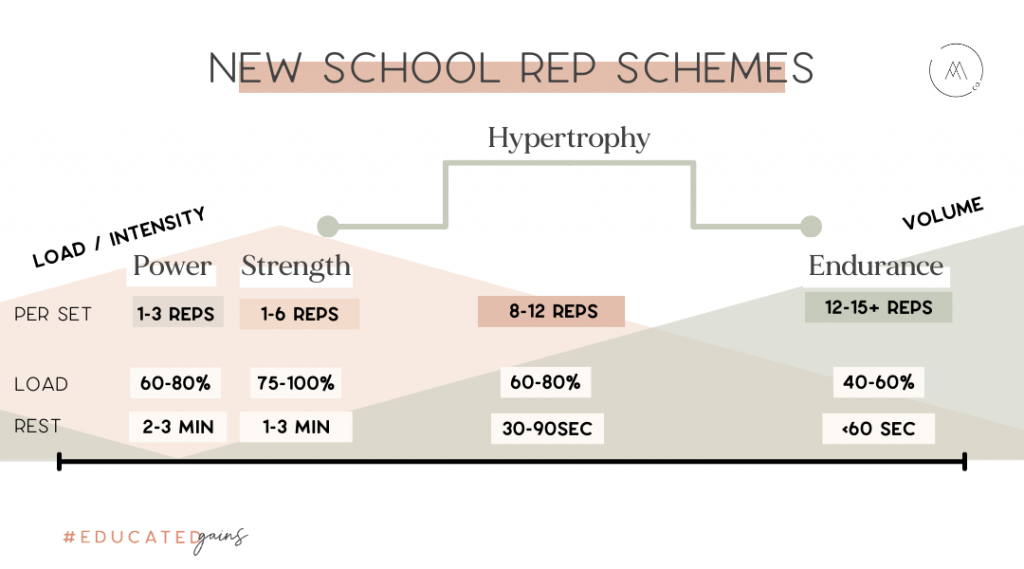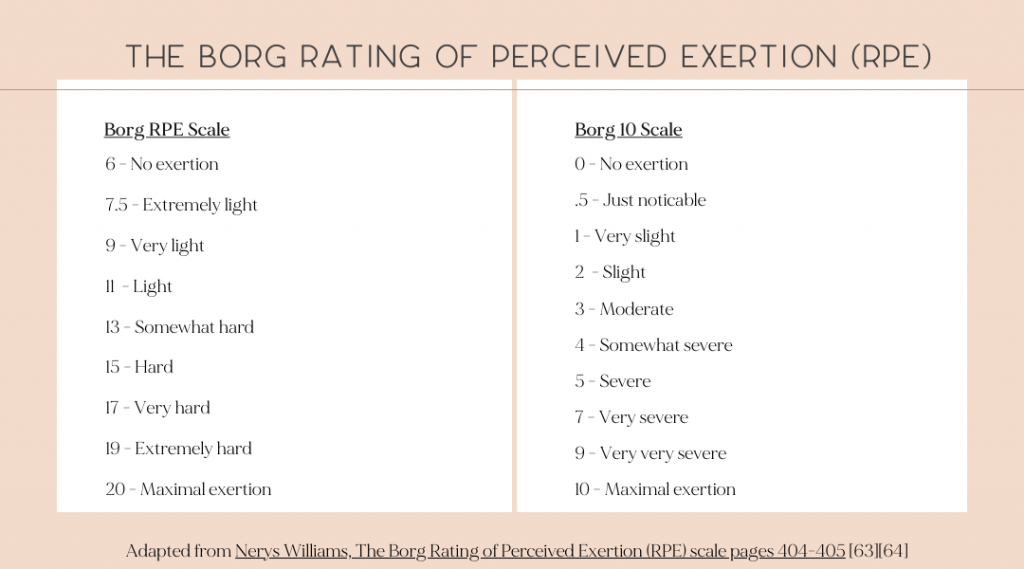the blog
welcome to
looking for something specific? find it here
My name is Annie Miller. I’m a certified strength and conditioning specialist, and I help you learn as you train and enjoy your lifts again. In this blog, we do that by giving you three ways to help you learn how to select your weights. Whether you are following a workout program from someone else or you are going at it alone.
Load isn’t everything when it comes to training. However, it is one of the most important factors when we are driving something called Mechanical Tension.
Mechanical Tension is the load/tension that we apply to muscles during training in order to get the desired adaptation that we want of muscle growth or an increase in strength.
We’ll dive into my personal favorite first… But keep reading through tip number three, which is possibly the most well-known loading prescription. However, I don’t think it’s the best method for most gym goers.
Choosing Weights Strategy #1: Rate of Perceived Exertion (RPE) & Reps in Reserve (RIR)
This first way to learn how to select the proper weights for your workout is actually two different methods. They kind of marry one another nicely.
One of the best ways to determine load is RPE or RIR. But first things first, you need to know these two things:
- What is the goal of the program you’re following?
- What is the goal for each specific exercise in that program?
While we are talking about load specifically… Load often depends on the volume of your sets and reps. So when you look at your exercise program, look at the sets and reps. That’s going to be your volume.
Generally, lower reps are going to leave room for a higher load. While higher reps are going to limit your load. I do wanna be clear that a lower load does not necessarily mean less challenging.
Your load is going to match whatever the reps are that are scheduled within the program. So it should be challenging no matter what, especially if building muscle or building strength is the goal.
This is where RPE or RIR comes in.
RPE can be used on a scale of 1-20 as originally created. But it is more commonly used now on a scale of 1-10. If your focus is Hypertrophy (muscle growth or strength), you are likely going to benefit from working at an RPE of 7 or above for most if not all of your working sets. As I mentioned earlier, RIR and RPE kind of work together as a marriage.


Think of RIR being the opposite of RPE.
If you’re working at an RPE of 7, think RIR of 3. I also like to say reps left “in the tank.” For example, I will tell a client, “Work until you have 2 more reps in the tank.” Which is essentially saying 2 RIR.
Choosing Weights Strategy #2: The Rule of Two
This is a playoff of RPE and RIR. It works particularly well if the load is not specified in whatever program you are following. This might be the case if it’s a templated program.
The Rule of Two is the idea that you would have two or less reps left in the tank at the end of each set. Meaning, that you probably could perform two more reps but they would be a struggle.
So your speed and maybe your form would start to slow a little bit and at the same time. If you are unable to get within two reps of the prescribed reps in the program, then you would need to decrease that load. But that would still count as a working set because it was a challenging load.
As you can see, The Rule of Two is somewhat of a loose approach to selecting your weight load. I do find that it works for most people getting them close to where they need to be for their working sets.
Choosing Weights Strategy #3: Percentages & AMRAPS
The third and final way to help choose your weight load is technically two different loading methods.
1. Percentages
2. AMRAPS (As Many Reps As Possible)
Both are based on determining some kind of baseline first before actually moving into your working sets.
Using Percentages is the most popular loading method that I mentioned at the beginning of this blog. It is likely the original loading method within the strength training world. This refers to working sets being based off of an individual’s one rep max. So how much load can they move for one rep?
In regards to RPE, that would be a zero RIR or a 10 RPE. This approach, in my opinion, makes the most sense for large compound movements.
Compound Movements = movements that involve multiple joints and multiple muscle groups. (i.e. squat, bench, deadlift, overhead press, pull up, and variations of these exercises)
Now using percentages is not necessarily confined to these types of compound movements, but that is where you commonly see this loading method used in the strength and hypertrophy world.
Here come my TWO issues with the loading method of percentages.
Issue #1: Training age (not biological age, this is time of training experience)
Issue #2: Daily variance in energy and stress levels
Now, I think the pendulum may have swung a bit too aggressively, as it does… From the “no pain, no gain, no days off” narrative, to “listen to your body, if you’re stressed don’t lift, you need to train around your menstrual cycle.”
Listen, we lack significant data to back the need for changing your training around your menstrual cycle or something that’s called cycle synching. Perhaps that’s another topic for another blog.
Issue #1 with Percentages: Someone’s training age, or years they’ve been training.
Based on experience, I think that working with percentages requires someone to be at least an intermediate lifter. You need experience working up to a true 1RM (1 Rep Max) with proper movement integrity in order to then continue to work on percentages based off of that true 1RM. I just don’t think that you can acquire it if you haven’t had a year or two or three working under those true heavier loads.
On the flip side, the positive of working on percentages is that the work is done for you as a coach or trainee. All you have to do is calculate the load based on the 1RM.
No brain work required.
Issue #2 with Percentages: Daily variance in energy and stress level.
This hits close to home for me both in my own training and in training clients over the last decade. For example, on week two of your training, let’s say you are scheduled to lift a load that is 85% of your one rep max (1RM). And on week two that load happens to feel like only 75% and you had more to give. But then you may enter into week three and now that same load at 85% feels like you’re lifting 95% and you are unable to complete the reps that are prescribed at that given load.
In an ideal world, there wouldn’t be these big energy swings and how much we have to give in each training session. This is also why I prefer RPE and RIR to use with my personal clients and in my own training.
This is also why I think that AMRAPS might be the best choice for a newer trainee and someone with a young training age. You can think of AMRAPS in this context as the opposite end of the spectrum as 1RM.
So you are going to choose a weight that you think you can perform for 10-12 reps and you are going to perform as many reps as you possibly can (with good form) until your velocity simply slows to the point that you reach failure (when you just cannot move the weight anymore). That is the number that you are going to work with. Ideally, that number is within five reps of the goal of that 10-12 reps.
If you happen to get within that five reps of the 10-12 reps, so you complete 15-17 reps until failure, you can go ahead and just use that weight for all of your subsequent working sets. If you get more than those 15-17 reps, then you would want to increase the load by 2-5 pounds for the rest of your working sets
AMRAPS are a great way to build the subjectivity needed for RPE and RIR. It’s hard to determine what 2-3 RIR or 7-8 RPE feels like if you have never worked to failure.
All of these loading methods have gaps and best practices. No matter which you choose, there will be a learning curve.
Conclusion:
If not working on percentages – RPE, RIR, and AMRAPS will take some trial and error to figure out. THAT’S OKAY! EXPECT THIS. Take a bit more time upfront when starting a new program to find the most appropriate working loads for you, and don’t be afraid to change your load from set to set if needed.
BONUS TIP:
Here is a bonus tip that addresses one of the most common questions or insecurities when it comes to choosing your weight load which is:
What do you do if you finish a set and you are unsure if you used the right load?
More specifically, if you used a heavy enough load, does that set actually count as a working set or should it be a warmup set? If you’re wanting to get the most out of your program (as your program is written), then you want to be able to confidently answer this question.
Think back to Rule of Two – if you finish within two reps but couldn’t complete all reps, that set counts, lower the load, and keep going.
If you finish a set and have more than two reps left in the tank (and it’s not RIR 3 or RPE under 7), then use that as a warm up set, up the weight, and start a new working set at a slightly higher load.
Not Sure What Program To Follow?
If your current training goal is to build muscle and you’re not sure what program to follow, then check out this blog on the best training split for building muscle.
Join The Discussion:
Before you go, be sure to join the discussion and drop any questions in the comments below.
Sign up for Daily Dose & Weekly Wisdom emails for more expert fitness and business advice. Click here to get more educated gains sent directly to your inbox.
I'm an adventurous introvert from Vancouver, Washington who lives on sleep + "me time." I'm a lover of lifting weights, dinosaurs, real talk and traveling with my husband. I am here to help you move better, lift more, bust the myths of the fitness industry, and inspire you to love the process.
Hey you,
The name's Annie & you're reading my thoughts. Let's get acquainted.
the whole story >
looking for something specific? find it here
THE LINKS BELOW ARE AFFILIATE LINKS
SKIN CARE
Nutrition
brands I love
working against gravity
Fre skin care
favorites
blue light blockers
klassy network
code: fdba saves you 15% off
online TRAINERS
save $50
code: ANNIE saves you 20% off
You love my style, trust my reviews, and want more Annie Miller Concepts vibes in your life? Shop my favorite brands. You get awesome products and yours truly gets a little kick-back.
